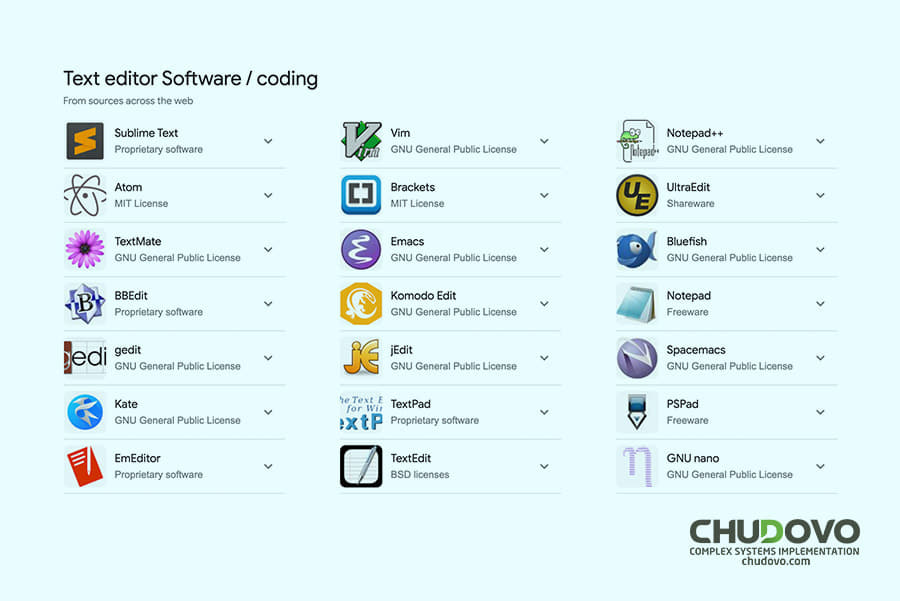Top Java IDEs and Text Editors for Efficient Coding: Insights and Recommendations
In the advanced world of Java development, the tools a developer employs can significantly influence the efficiency, speed, and overall quality of the code they write. Integrated Development Environments (IDEs) and Java Text Editors have emerged as imperative tools for improving coding productivity.
IDEs have revolutionized software development with their ability to integrate several tools into a unified platform. An IDE consists of a source code editor, build automation tools, and a debugger, all housed within a single graphical user interface. For Java developers, IDEs such as Eclipse, IntelliJ IDEA, NetBeans, and JDeveloper offer an array of features that support seamless code creation, testing, and debugging, thus aiding in efficient software development.
Java Text Editors, while not as feature-rich as IDEs, are often favoured for their simplicity and quick startup times. Text editors such as Sublime Text, Atom, or Notepad++ offer a lighter, more streamlined approach to code editing, particularly suitable for smaller projects or quick code adjustments.
The decision to choose an IDE or a Text Editor often boils down to the project’s complexity, the developer’s proficiency, and the integration and collaboration needs within the team. Let’s dive into the comprehensive insights and recommendations on the top Java IDEs and text editors, ensuring you can make an informed choice that meets your development needs.
Table of Contents
- Understanding Java IDEs and Text Editors
- More about IDEs for Java
- Insight into Text Editors for Java
- Top Java Text Editors
- IDEs vs Text Editors: Which One to Choose?
- Key Recommendations and Best Practices
- Conclusion
- Frequently Asked Questions (FAQs)

Understanding Java IDEs and Text Editors
Embarking on the journey of Java development requires a concrete understanding of its principle apparatus – Java Integrated Development Environments (IDEs) and Java Text Editors. These formidable resources prepare developers with the capability to craft, refine, troubleshoot, and enhance code adeptly, laying the important foundation for successful software development endeavours.
Difference between IDEs and Text Editors
While IDEs and Text Editors share the common objective of aiding developers in code creation, they differ in complexity, feature sets, and targeted use cases.
An IDE is a thorough software suite that consolidates several development tools into a single interface. This combination typically includes a source code editor, compiler, debugger, and build automation tools. In the context of Java, IDEs such as Eclipse, IntelliJ IDEA, and NetBeans provide a holistic environment for developers to write, debug, and run Java applications, often increased by features such as syntax highlighting, code suggestions, and automatic error detection.
On the other hand, Text Editors are lightweight applications designed and established for writing and editing code. They offer fewer features than IDEs but excel in simplicity and speed, making them specifically suitable for smaller projects or quick code adjustments. Java Text Editors, like Sublime Text or Notepad++, typically provide basic features like syntax highlighting and some level of automation but do not offer comprehensive debugging or compiling capabilities found in IDEs.
Criteria for Choosing an IDE or Text Editor
The complexity of your project is a massive determinant in choosing the right tool for your Java development projects. Integrated Development Environments (IDEs) are typically better suited for large-scale, intricate projects as they come equipped with integrated tools for debugging, testing, and deployment. However, text editors are generally more suitable for simpler, smaller-scale projects or for making quick edits to code.
The next criterion is your project’s specific feature requirements. If your project requires you to employ advanced functionalities such as code refactoring, integrated debugging, or code profiling, an IDE might be the compatible option. On the other hand, if your primary need is a tool for writing and making minor edits to code, a text editor could be more than adequate.
Another determining factor is performance. IDEs, thanks to their extensive functionalities, are usually more demanding on system resources than text editors. But the latter might be a consideration for systems with limited processing capabilities.
In addition to the aforementioned determinants, the learning curve associated with the tool is also noteworthy. IDEs often have a steeper learning curve compared to text editors because of their plethora of features and tools. Finally, if your project requires close-knit collaboration amongst team members or needs to integrate with other tools or platforms, you must ensure that your chosen IDE or text editor can accommodate these requirements.
More about IDEs for Java
When working on any software development project in the realm of Java, it’s crucial to comprehend the fundamental tools at your disposal. One of the integral tools for a Java developer is the Java Integrated Development Environment, typically referred to as a Java IDE. But first, let’s find out what an IDE is and what makes it one of the most preferred choices of Java developers.
What is an IDE?
An Integrated Development Environment, or IDE, is a software suite that incorporates the basic tools required to write and test software. It offers a thorough ecosystem dedicated to easing the process of Java development. Unlike a simple text editor, an IDE provides a more holistic, feature-rich platform that facilitates the efficient writing, debugging, compiling, and running of Java code.
Features of a Good Java IDE
A good Java IDE is known for its comprehensive and advanced set of features. At its core, it has an advanced code editor that offers features like syntax highlighting, bracket matching, auto-indentation, and auto-completion, which streamline the coding process. Besides, a sophisticated IDE is equipped with a built-in compiler or interpreter, allowing developers to execute the program from the IDE itself and check their code in real time.
Debugging tools are another significant feature of a strong Java IDE, enabling developers to test their code for errors and fix them instantly. In addition to this, many IDEs provide features like code refactoring and static code analysis that help maintain the quality of code. They also have integrated tools for project management, version control systems, and automated build processes, enabling developers to manage their work effectively and collaboratively.
Pros and Cons of Using an IDE
Using an IDE comes with an array of advantages. The combination of several development tools and features into one package simplifies the development process, thereby enhancing productivity. However, with these advantages come a few drawbacks as well.
One of the main disadvantages of using an IDE is that it can be overwhelming, especially for beginners. The series of tools and features they offer can be confusing, and there can be a steep learning curve associated with understanding how to use them to get the most out of them. IDEs also tend to be more resource-intensive than simple text editors. Therefore, they might not be the best choice for older machines with limited processing power.

Insight into Text Editors for Java
While Integrated Development Environments (IDEs) provide a comprehensive suite of tools for Java development, there’s another essential tool in the developer’s arsenal that offers a leaner approach — the text editor. Understanding the nature, features, and uses of text editors in Java coding is critical to make informed choices about the best tools for your projects.
What is a Text Editor?
A text editor, as its name suggests, is a software application for creating and modifying plain text files. Unlike IDEs, text editors are typically lightweight, less complex, and more focused on the core task of writing and editing code. Java text editors are those that support the syntax and some specific features of Java, which helps developers code more efficiently.
Features of a Good Text Editor for Java
A good text editor for Java will offer a host of features that make coding easier and faster. These can include syntax highlighting, where different parts of the code are displayed in different colours to make the structure easier to understand; line numbering, to locate and reference code easily; and code completion, which can save the developer time by completing commonly used Java phrases.
Some text editors also offer more advanced features like a spell checker, search and replace functionality, and the ability to handle large files without performance degradation.
Advantages and Disadvantages of Using a Text Editor
There are definite advantages to using a text editor for Java coding. They are generally more lightweight and faster than IDEs, making them ideal for simpler or smaller-scale projects or when working on a machine with limited resources. Text editors also provide greater flexibility, as they typically allow you to work in multiple programming languages without needing to switch tools.
However, text editors are not without their disadvantages. They don’t offer the same level of functionality as IDEs and can’t handle complex tasks such as debugging, automated testing, or project management. This makes them less suited to large-scale, complex Java projects. Also, while they are generally easier to learn and use than IDEs, they might lack some of the time-saving features found in IDEs, such as advanced code completion and refactoring tools.

Top Java Text Editors
The universe of Java text editors is vast and varied, with a multitude of options designed to meet diverse coding needs. Here, we delve into three of the top Java text editors: Sublime Text, Atom, and Notepad++. Each editor has unique attributes that can enhance your coding efficiency, depending on your project’s specific requirements.
Sublime Text: Features and Benefits
Let’s begin with Sublime Text, a sophisticated text editor for code, markup, and prose. Favoured for its slick user interface and exceptional features, Sublime Text offers functionality that can be significantly enhanced with plugins, making it a highly versatile tool.
Key features of Sublime Text include a minimap of the entire code file for easy navigation, multiple selections to change many lines at once, and an incredibly fast and responsive interface. These features can be advantageous in writing and editing Java code, allowing developers to handle complex code files effortlessly.
Atom: Features and Benefits
Moving on, we have Atom, a free and open-source text editor known for its flexibility and integration capabilities. Atom, created by GitHub, has a built-in package manager for installing new packages or start creating your own within this versatile editor. Its standout features include auto-completion, a file system browser, multiple panes, and a find and replace function. Being a hackable text editor, Atom allows you to customize it to suit your needs, whether it’s coding in Java or any other language.
Notepad++: Features and Benefits
Last but certainly not least is Notepad++, a powerful open-source text editor that supports several programming languages, including Java. Its key features include syntax highlighting and syntax folding, PCRE (Perl Compatible Regular Expression) search/replace, auto-completion, multi-document and multi-view, and support for macros. Its lightweight application and high execution speed make Notepad++ a favourite among many developers.
Comparison of Top Java Text Editors
Sublime Text shines in its speed and performance and offers a pleasing coding environment with its well-designed UI. Atom stands out in terms of customizability and integration, providing developers with a versatile platform for their coding needs. Notepad++, on the other hand, is known for its simplicity and speed, providing an efficient, no-nonsense coding environment.
However, the choice of text editor ultimately hinges on your specific needs and coding preferences. If you often work with large files and want a responsive, intuitive interface, Sublime Text might be the right choice. If integration and customization are important to you, then Atom’s hackable interface and extensive package community can be beneficial. For developers seeking a lightweight, fast, and powerful editor, Notepad++ could be the preferred option.

IDEs vs Text Editors: Which One to Choose?
Choosing the appropriate tool for coding, be it an Integrated Development Environment (IDE) or a text editor, is a pivotal decision for developers. The complexity of the task at hand, the scale of the project, the specific requirements, and even the coding style can greatly influence this choice. The crucial aspect to understand here is that there’s no one-size-fits-all solution, and the choice between Java IDEs and text editors is often a matter of context, necessitating a situational analysis.
For extensive, complex projects in Java development, IDEs such as NetBeans, IntelliJ IDEA, and Eclipse have proven to be exceptionally beneficial. These integrated environments come loaded with features like build automation, code linting, version control, and debugging tools. These functionalities are not merely additional features but vital aids that streamline various developmental processes. They automate numerous aspects of coding and significantly enhance the efficiency of the development cycle, making IDEs an indispensable tool for enterprise-grade applications.
On the other end of the spectrum, text editors, including Sublime Text, Atom, and Notepad++, have their unique strengths. These tools are designed to be lightweight and uncomplicated, which makes them highly suitable for simpler tasks or quick edits. In situations where the primary requirement is to write or modify code rapidly, without the need for extensive features or tools, text editors stand out. Moreover, they are less resource-intensive compared to IDEs, making them a preferable choice for systems with limited processing power.
Key Recommendations and Best Practices
Navigating the world of Java coding demands a keen understanding of the tools at your disposal, be it an Integrated Development Environment (IDE) or a text editor. Yet, beyond the selection of a tool, there are further considerations to ensure efficient and effective coding. This segment aims to offer key recommendations and best practices to enhance your coding proficiency, regardless of whether you choose to work in a Java IDE or a text editor.
Tips for Efficient Coding in Java
It is crucial to note that efficient coding extends beyond choosing the right IDE or text editor. The way you utilize these tools significantly impacts your development workflow. Here are some considerations to optimize your coding experience in Java.
Understand the Tool’s Features
Whether you’re working in an IDE like IntelliJ IDEA, NetBeans, or Eclipse or using a text editor like Sublime Text, Atom, or Notepad++, take the time to understand and master their features. Both Java IDEs and text editors offer a variety of built-in features to enhance productivity, such as auto-completion, syntax highlighting, and debugging tools. Leveraging these tools effectively can significantly streamline your coding process.
Stay Updated with the Latest Developments
As Java continues to evolve, so do the tools used for Java development. It’s important to stay up-to-date with the latest updates and versions of your chosen IDE or text editor. The development environment in technology is dynamic and constantly improving with new features, bug fixes, and enhancements. This also applies to the Java language itself.
Emphasize Code Quality
Regardless of the tool used, maintaining high-quality code should be a priority. This involves following good coding practices such as writing readable and clean code, using comments to document your code, and consistently testing your code to ensure it is bug-free. A well-structured codebase is easier to maintain and modify, improving long-term efficiency.
Customize Your Tool
Most IDEs and text editors offer customizable features. You can tweak the interface, shortcuts, or plugins to fit your needs. Customizing your IDE or text editor can greatly enhance your coding experience and make it more efficient. Consider Your Project Needs: It’s crucial to remember that every project is different. The choice of tool should depend on the project’s complexity, the need for collaboration, and integration with other technologies.

Certified engineers
Convenient rates
Fast start
Profitable conditions
Agreement with
EU company
English and German
speaking engineers
Conclusion
In wrapping up our exploration of top Java IDEs and text editors, the choice between these tools hinges on the specifics of your project and personal coding preferences. Java IDEs, equipped with extensive features like debugging, testing, and build automation, are better suited for complex projects.
On the contrary, text editors offer a lightweight solution for simpler tasks or quick edits due to their simplicity and speed. It’s not about superiority but rather adapting the tool to fit the task. The ideal environment allows efficient code writing, modification, testing, and optimization, whether it’s an IDE or a text editor.
Frequently Asked Questions (FAQs)
What are the differences between a Java IDE and a text editor?
The main difference lies in their complexity and features. Java IDEs are more advanced and come with integrated tools such as debuggers, compilers, and auto-completion features, making them ideal for large-scale projects. Text editors, on the other hand, are simpler and offer basic functionality for writing and editing code, making them ideal for smaller projects or quick code edits.
How do I choose between a Java IDE and a text editor?
Choosing between a Java IDE and a text editor largely depends on your project requirements, including complexity, performance, feature requirements, and learning curve. For large-scale and complex projects, an IDE may be the best choice due to its integrated tools. Conversely, text editors are best suited for smaller projects or tasks that require quick code edits.
What are some of the top Java IDEs recommended for efficient coding?
Some of the top Java IDEs for efficient coding include IntelliJ IDEA, Eclipse, and NetBeans. Each of these IDEs provides robust features, including code assistance, debugging tools, and integrated build automation, that can streamline the coding process.
What are some good text editors for Java coding?
Sublime Text, Atom, and Notepad++ are popular text editors for Java coding. They are lightweight, easy to use, and offer basic functionality for writing and editing code.
What are some key features to look for in a Java IDE or a text editor?
For a Java IDE, important features might include debugging tools, code assistance, and integrated build automation. For a text editor, look for features such as syntax highlighting, search and replace functionality, and customization options. Ultimately, the choice of features should align with your project requirements and personal preferences.
If you need highly qualified Java developers at the right price for your project, Contact us now, and let’s discuss it!




